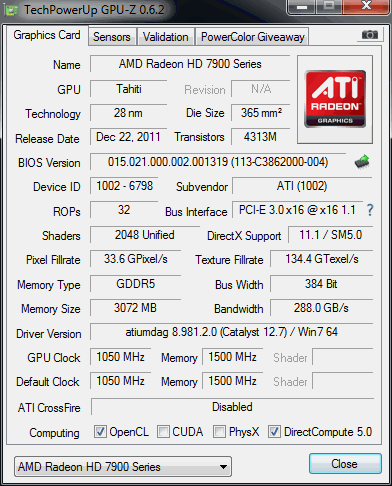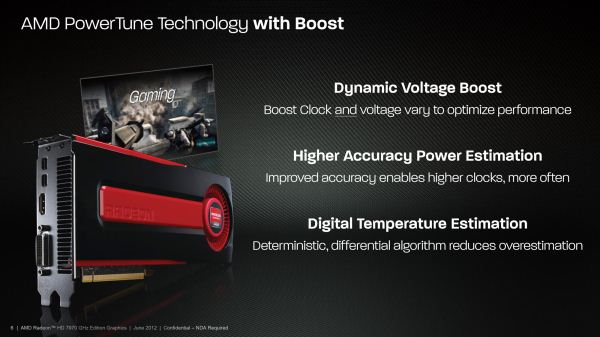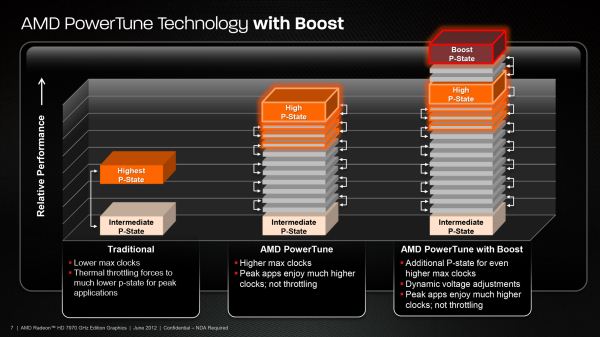AMD Radeon HD 7970 GHz Edition Review: Battling For The Performance Crown
by Ryan Smith on June 22, 2012 12:01 AM EST- Posted in
- GPUs
- AMD
- GCN
- Radeon HD 7000
Introducing PowerTune Technology With Boost
Since the 7970GE’s hardware is identical to the 7970, let’s jump straight into AMD’s software stack.
With the 7970GE AMD is introducing their own form of GPU Boost, which they are calling PowerTune Technology With Boost (PT Boost). PT Boost is a combination of BIOS and Catalyst driver changes that allow AMD to overdrive the GPU when conditions permit, and can be done without any hardware changes.
In practice PT Boost is very similar to NVIDIA’s GPU Boost. Both technologies are based around the concept of a base clock (or engine clock in AMD’s terminology) with a set voltage, and then one or more boost bins with an associated voltage that the GPU can move to as power/thermal conditions permit. In essence PT Boost allows the 7970GE to overvolt and overclock itself to a limited degree.
With that said there are some differences in implementation. First and foremost, AMD isn’t pushing the 7970GE nearly as far with PT Boost as NVIDIA has the GTX 680 with GPU Boost. The 7970GE’s boost clock is 1050MHz, a mere 50MHz better than the base clock, while the GTX 680 can boost upwards of 100MHz over its base clock. So long as both companies go down this path I expect we’ll see the boost clocks move higher and become more important with successive generations, just like what we’ve seen with Intel and their CPU turbo boost, but for the time being GPU turboing is going to be far shallower than what we’ve seen on the CPU.
At the same time however, while AMD isn’t pushing the 7970GE as hard as the GTX 680 they are being much more straightforward in what they guarantee – or as AMD likes to put it they’re being fully deterministic. Every 7970GE can hit 1050MHz and every 7970GE tops out at 1050MHz. This is as opposed to NVIDIA’s GPU Boost, where every card can hit at least the boost clock but there will be some variation in the top clock. No 7970GE will perform significantly better or worse than another on account of clockspeed, although chip-to-chip quality variation means that we should expect to see some trivial performance variation because of power consumption.
On that note it was interesting to see that because of their previous work with PowerTune AMD has far more granularity than NVIDIA when it comes to clockspeeds. GK104’s bins are 13MHz apart; we don’t have an accurate measure for AMD cards because there are so many bins between 1000MHz and 1050MHz that we can’t accurately count them. Nor for that matter does the 7970GE stick with any one bin for very long, as again thanks to PowerTune AMD can switch their clocks and voltages in a few milliseconds as opposed to the roughly 100ms it takes NVIDIA to do the same thing. To be frank in a desktop environment it’s not clear whether this is going to make a practical difference (we’re talking about moving less than 2% in the blink of an eye), but if this technology ever makes it to mobile a fast switching time would be essential to minimizing power consumption.
Such fast switching of course is a consequence of what AMD has done with their internal counters for PowerTune. As a reminder, for PowerTune AMD estimates their power consumption via internal counters that monitor GPU usage and calculate power consumption based on those factors, whereas NVIDIA simply monitors the power going into the GPU. The former is technically an estimation (albeit a precise one), while the latter is accurate but fairly slow, which is why AMD can switch clocks so much faster than NVIDIA can.
For the 7970GE AMD is further refining their PowerTune algorithms in order to account for PT Boost’s voltage changes and to further improve the accuracy of the algorithm. The big change here is that on top of their load based algorithm AMD is adding temperatures into the equation, via what they’re calling Digital Temperature Estimation (DTE). Like the existing PowerTune implementation, DTE is based on internal counters rather than an external sensor (i.e. a thermal diode), with AMD using their internal counters and knowledge about the cooling system to quickly estimate the GPU’s temperature similar to how they estimate power consumption, with a focus on estimating power in and heat out in order to calculate the temperature.
The end result of this is that by estimating the temperature AMD can now estimate the leakage of the chip (remember, leakage is a function of temperature), which allows them to more accurately estimate total power consumption. For previous products AMD has simply assumed the worst case scenario for leakage, which kept real power below AMD’s PowerTune limits but effectively overestimated power consumption. With DTE and the ability to calculate leakage AMD now has a better power estimate and can push their clocks just a bit higher as they can now tap into the headroom that their earlier overestimation left. This alone allows AMD to increase their PT Boost performance by 3-4%, relative to what it would be without DTE.
AMD actually has a longer explanation on how DTE works, and rather than describing it in detail we’ll simply reprint it.
DTE works as a deterministic model of temperature in a worst case environment, as to give us a better estimate of how much current the ASIC is leaking at any point in time. As a first order approximation, ASIC power is roughly a function of: dynamic_power(voltage, frequency) + static_power(temperature, voltage, leakage).
Traditional PowerTune implementations assume that the ASIC is running at a worst case junction temperature, and as such always overestimates the power contribution of leaked current. In reality, even at a worst case ambient temp (45C inlet to the fansink), the GPU will not be working at a worst case junction temperature. By using an estimation engine to better calculate the junction temp, we can reduce this overestimation in a deterministic manner, and hence allow the PowerTune architecture to deliver more of the budget towards dynamic power (i.e. frequency) which results in higher performance. As an end result, DTE is responsible for about 3-4% performance uplift vs the HD7970 GHz Edition with DTE disabled.
The DTE mechanism itself is an iterative differential model which works in the following manner. Starting from a set of initial conditions, the DTE algorithm calculates dTemp_ti/dt based on the inferred power consumption over a previous timeslice (is a function of voltage, workload/capacitance, freq, temp, leakage, etc), and the thermal capacitance of the fansink (function of fansink and T_delta). Simply put, we estimate the heat into the chip and the heat out of the chip at any given moment. Based on this differential relation, it’s easy to work back from your initial conditions and estimate Temp_ti, which is the temperature at any timeslice. A lot of work goes into tuning the parameters around thermal capacitance and power flux, but in the end, you have an algorithmic way to always provide benefit over the previous worst-case assumption, but also to guarantee that it will be representative of the entire population of parts in the market.
We could have easily done this through diode measurements, and used real temperature instead of digital temperature estimates…. But that would not be deterministic. Our current method with DTE guarantees that two parts off the shelf will perform the same way, and we enable end users to take advantage of their extra OC headroom on their parts through tools like Overdrive.
By tapping into this headroom however AMD has also increased their real power consumption at lower temperatures and leakages, which is why despite the identical PowerTune limits the 7970GE will consume more power than the 7970. We’ll get into the numbers in our benchmarking section, but it’s something to keep in mind for the time being.
Finally, on the end-user monitoring front we have some good news and some bad news. The bad news is that for the time being it’s not going to be possible to accurately monitor the real clockspeed of the 7970GE, either through AMD’s control panel or through 3rd party utilities such as GPU-Z. As it stands AMD is only exposing the base P-states but not the intermediate P-states, which goes back to the launch of the 7970 and is why we have never been able to tell if PowerTune throttling is active (unlike the 6900 series). So for the time being we have no idea what the actual (or even average) clockspeed of the 7970GE is. All we can see is whether it’s at its boost P-state – displayed as a 1050MHz core clock – or whether it’s been reduced to its P-state for its base clock, at which point the 7970GE will report 1000MHz.

The good news is that internally of course AMD can take much finer readings (something they made sure to show us at AFDS) and that they’ll finally be exposing these finer readings to 3rd party applications. Unfortunately they haven’t given us an expected date, but soon enough their API will be able to report the real clockspeed of the GPU, allowing users to see the full effects of both PT Boost and PT Throttle. It’s a long overdue change and we’re glad to see AMD is going to finally expose this data.












110 Comments
View All Comments
Belard - Friday, June 22, 2012 - link
Agreed.Articuno - Friday, June 22, 2012 - link
A whole new card launch and yet another pair of similarly named but differently performing products because they changed a few numbers that anyone can in several free, easily available programs.I suppose they can do this because you can actually buy their products though, unlike the 6XX series.
ExarKun333 - Friday, June 22, 2012 - link
Yeah, tough to find 6xx products indeed. There is something called the 'internet' you could check out. Your buddy who posted for you might be able to help you out. ;)Pantsu - Friday, June 22, 2012 - link
I doubt any AIB will actually release GE cards with reference cooling. Most likely they will be custom cooled, so the loudness of the reference card is a bit of a moot point.It's good to see some decent driver improvements from AMD. I'm still quite happy about 7970 performance at 5760x1080, and it's enough for most games when OC'd. It would be interesting to see though, whether the GE has improved the max OC. Most likely it's no better though, and you'll be better off buying an old custom 7970 for a good price and OC'ing it to the same levels as the GE.
dagamer34 - Friday, June 22, 2012 - link
The GE chips are better binned parts, one would assume that they have a bit more room for higher clocks than the normal 7970 parts. Certainly the average overclock will be higher.CeriseCogburn - Saturday, June 23, 2012 - link
So we can deduce that the prior 7970 overclocks were sucking down an even larger amount of enormous electrical power as those chips are of lower bin.I guess we need an overclocked power suction chart with an extended table for the amd housefire 7970.
Any savings on card price or a few frames at a resolution near no one owns will be gobbled up by your electric bill every month for years - save 1 watt or 9 watts at extended idle, but when you game it's 100+ watts and beyond with the overclocked 7970 - maybe they should be $300 with 3 games.
silverblue - Monday, June 25, 2012 - link
Well, it works both ways. You won't always be gaming, in addition there's all that compute hardware that, if properly harnessed, would save you money over competing solutions because you'd get the job done quicker. It used to be pointless to consider using anything for compute that wasn't a Quadro, Tesla or even FirePro, however those days are coming to an end.Having a 7970 will make sense for compute if that's your bag (there's a reason for the die size plus the extra memory and bus width), but this time, NVIDIA enjoys a performance/watt advantage which might go unchallenged for a while. Unless, of course, that extra hardware on the 7970 is properly leveraged; future games, perhaps?
ltcommanderdata - Friday, June 22, 2012 - link
So do we think this will encourage nVidia to release a GeForce GK110 based product in the next few months rather than restrict it to Tesla?PsiAmp - Friday, June 22, 2012 - link
Nvidia isn't holding GK110 in its sleeve waiting for something. It is unfinished in the first place and there's no manufacturing capacity to produce such a large chip. Nvidia still struggles to fix GK104 design to have good yields. GK110 would be impossible to produce in since it is twice bigger and such will have at least 4 times less yield.Server market is not only much more profitable, it is operating on a contract basis. Nvidia will start to produce Tesla K20 in Q4 2012.
IF(?) desktop card based on GK110 will hit the market it won't be sooner than Q1 2013. And it is not something that you can change really.
silverblue - Friday, June 22, 2012 - link
"Of course this isn’t the first time we’ve had a hot & loud card on our hands – historically it happens to NVIDIA a lot – but when NVIDIA gets hot & loud they bring the performance necessary to match it. Such was the case with the GTX 480, a notably loud card that also had a 15% performance advantage on AMD’s flagship. AMD has no such performance advantage here, and that makes the 7970GE’s power consumption and noise much harder to justify even with a “performance at any cost” philosophy."Very true, however the power consumption and heat difference between the 5870 and the 480 was definitely more pronounced.
The 680 is an incredible card, no doubt about it. It may not win in some titles, but it's hardly anywhere near unplayable either. AMD being right there at the very high end is fantastic but unless titles truly make use of GCN's compute ability, the extra power and noise are going to be hard to swallow. Still, I'd own either. :P